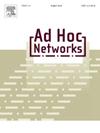基于群智能的太赫兹(THz)无人机网络定位和功率控制
IF 4.4
3区 计算机科学
Q1 COMPUTER SCIENCE, INFORMATION SYSTEMS
引用次数: 0
摘要
近年来,太赫兹(THz)通信作为高速无线网络的变革性技术获得了极大的关注,解决了传统频段在满足不断增长的数据传输需求方面的局限性。太赫兹通信在基于车辆到一切(V2X)和无人机(UAV)的通信网络中尤为重要,在这些网络中,超低延迟、高带宽和可靠的连接至关重要。太赫兹通信在微波和红外波段之间的频谱中工作,提供了千兆数据传输速率的潜力,使其成为下一代智能交通系统、自动驾驶汽车和无人机支持应用的有前途的推手。此外,通过预测网络流量模式和移动动态,人工智能(AI)成为提高基于thz的V2X和无人机通信网络可靠性和效率的关键工具。本研究介绍了一种基于群体智能的人工智能方法,旨在通过最小化延迟和传输功率要求来优化系统性能,同时确保在太赫兹频段运行的无人机辅助车辆网络中所需的信噪比(SNR)。提出的方法采用双目标优化框架,在预定义的通信时间框架内平衡延迟和传输功率。将无人机随机分布的基线网络与基于所提AI方案的无人机部署网络进行对比分析。并将该方法与已有的群体智能算法进行了性能比较。评估性能指标,包括信噪比和延迟,以评估系统的有效性。通道建模过程利用逐行辐射传输模型(LBLRTM)来表征无人机辅助车辆网络中的传播环境。本文章由计算机程序翻译,如有差异,请以英文原文为准。
Swarm intelligence-inspired localization and power control for terahertz (THz) UAV-vehicle networks
In recent years, terahertz (THz) communication has gained significant attention as a transformative technology for high-speed wireless networks, addressing the limitations of conventional frequency bands in meeting the escalating demand for data transmission. THz communication is particularly critical in vehicle-to-everything (V2X) and unmanned aerial vehicle (UAV)-based communication networks, where ultra-low latency, high bandwidth, and reliable connectivity are essential. Operating in the frequency spectrum between the microwave and infrared bands, THz communication offers the potential for multi-gigabit data transmission rates, rendering it a promising enabler for next-generation intelligent transportation systems, autonomous vehicles, and UAV-supported applications. Furthermore, artificial intelligence (AI) emerges as a pivotal tool to enhance the reliability and efficiency of THz-based V2X and UAV communication networks by enabling the prediction of network traffic patterns and mobility dynamics. This study introduces a swarm intelligence-based AI approach designed to optimize system performance by minimizing latency and transmission power requirements while ensuring the required signal-to-noise ratio (SNR) within a UAV-assisted vehicular network operating in the THz band. The proposed methodology employs a dual-objective optimization framework that balances latency and transmission power within a predefined communication time frame. Comparative analysis is conducted between a baseline network with randomly distributed UAVs and a network employing UAV deployment guided by the proposed AI scheme. Also, the performance of proposed method is compared with existing swarm intelligence algorithms. Performance metrics, including SNR and latency, are evaluated to assess the system’s efficacy. The channel modeling process leverages the Line-by-Line Radiative Transfer Model (LBLRTM) to characterize the propagation environment in the UAV-assisted vehicular network.
求助全文
通过发布文献求助,成功后即可免费获取论文全文。
去求助
来源期刊

Ad Hoc Networks
工程技术-电信学
CiteScore
10.20
自引率
4.20%
发文量
131
审稿时长
4.8 months
期刊介绍:
The Ad Hoc Networks is an international and archival journal providing a publication vehicle for complete coverage of all topics of interest to those involved in ad hoc and sensor networking areas. The Ad Hoc Networks considers original, high quality and unpublished contributions addressing all aspects of ad hoc and sensor networks. Specific areas of interest include, but are not limited to:
Mobile and Wireless Ad Hoc Networks
Sensor Networks
Wireless Local and Personal Area Networks
Home Networks
Ad Hoc Networks of Autonomous Intelligent Systems
Novel Architectures for Ad Hoc and Sensor Networks
Self-organizing Network Architectures and Protocols
Transport Layer Protocols
Routing protocols (unicast, multicast, geocast, etc.)
Media Access Control Techniques
Error Control Schemes
Power-Aware, Low-Power and Energy-Efficient Designs
Synchronization and Scheduling Issues
Mobility Management
Mobility-Tolerant Communication Protocols
Location Tracking and Location-based Services
Resource and Information Management
Security and Fault-Tolerance Issues
Hardware and Software Platforms, Systems, and Testbeds
Experimental and Prototype Results
Quality-of-Service Issues
Cross-Layer Interactions
Scalability Issues
Performance Analysis and Simulation of Protocols.
 求助内容:
求助内容: 应助结果提醒方式:
应助结果提醒方式:


